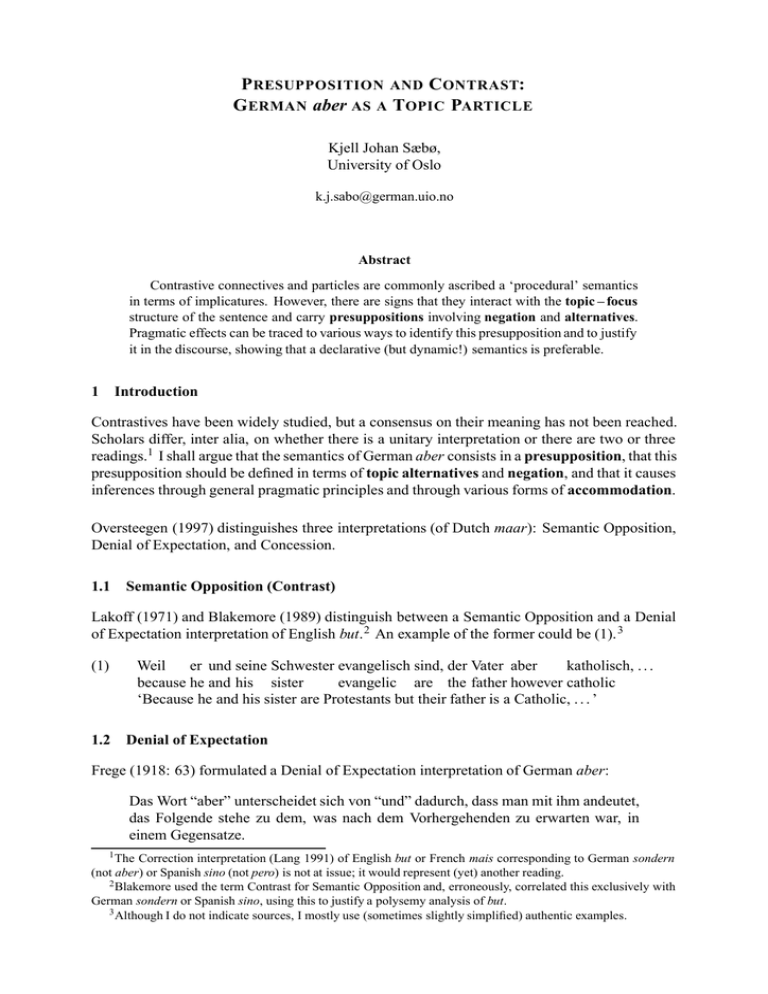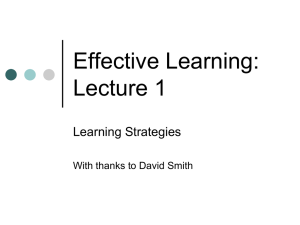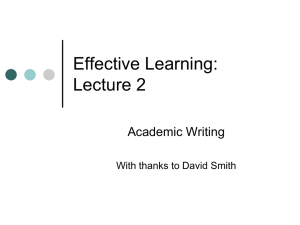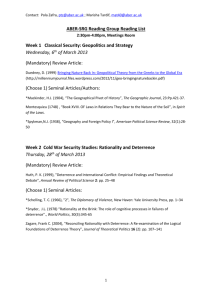P C : G
advertisement

P RESUPPOSITION AND C ONTRAST: G ERMAN aber AS A TOPIC PARTICLE Kjell Johan Sæbø, University of Oslo k.j.sabo@german.uio.no Abstract Contrastive connectives and particles are commonly ascribed a ‘procedural’ semantics in terms of implicatures. However, there are signs that they interact with the topic – focus structure of the sentence and carry presuppositions involving negation and alternatives. Pragmatic effects can be traced to various ways to identify this presupposition and to justify it in the discourse, showing that a declarative (but dynamic!) semantics is preferable. 1 Introduction Contrastives have been widely studied, but a consensus on their meaning has not been reached. Scholars differ, inter alia, on whether there is a unitary interpretation or there are two or three readings.1 I shall argue that the semantics of German aber consists in a presupposition, that this presupposition should be defined in terms of topic alternatives and negation, and that it causes inferences through general pragmatic principles and through various forms of accommodation. Oversteegen (1997) distinguishes three interpretations (of Dutch maar): Semantic Opposition, Denial of Expectation, and Concession. 1.1 Semantic Opposition (Contrast) Lakoff (1971) and Blakemore (1989) distinguish between a Semantic Opposition and a Denial of Expectation interpretation of English but. 2 An example of the former could be (1). 3 (1) 1.2 Weil er und seine Schwester evangelisch sind, der Vater aber katholisch, . . . because he and his sister evangelic are the father however catholic ‘Because he and his sister are Protestants but their father is a Catholic, . . . ’ Denial of Expectation Frege (1918: 63) formulated a Denial of Expectation interpretation of German aber: Das Wort “aber” unterscheidet sich von “und” dadurch, dass man mit ihm andeutet, das Folgende stehe zu dem, was nach dem Vorhergehenden zu erwarten war, in einem Gegensatze. 1 The Correction interpretation (Lang 1991) of English but or French mais corresponding to German sondern (not aber) or Spanish sino (not pero) is not at issue; it would represent (yet) another reading. 2 Blakemore used the term Contrast for Semantic Opposition and, erroneously, correlated this exclusively with German sondern or Spanish sino, using this to justify a polysemy analysis of but. 3 Although I do not indicate sources, I mostly use (sometimes slightly simplified) authentic examples. 2 Kjell Johan Sæbø The word “aber” differs from “und” by suggesting that what follows contradicts what would be expected from what precedes it. An example could be (2). (2) 1.3 Kamila und Ania sind katholisch, aber in die Kirche gehen sie nicht oft. Kamila and Ania are catholic but in the church go they not often ‘Kamila and Ania are Catholics, but they do not go to Church frequently.’ Concession Concession is a label for the reading of French mais or Hebrew aval which Anscombre and Ducrot (1977) and Dascal and Katriel (1977) called attention to, arguing for a general analysis in argumentation theoretical terms: The first sentence counts pro, the second sentence counts contra some conclusion (or topos). An example could be (3). (3) 1.4 Clever genug ist er, aber zu faul. clever enough is he but too lazy ‘He is clever enough, but he’s too lazy.’ A Common Denominator? It is unsatisfactory to have to assume three different readings for what seems to be one word. And in fact, Blakemore (2000: 474) formulates a general Denial of Expectation analysis which can be considered to subsume Concession: . . . the segment introduced by but communicates . . . a proposition that contradicts . . . a proposition which the speaker believes is manifestly inferrable . . . [ . . . ] . . . in uttering the but segment, the speaker is communicating that she is attributing to the hearer the derivation of an assumption that is not justified. Actually, as Dascal and Katriel (1977: 148f.) point out, Denial of Expectation can be seen as that special case of Concession where the second sentence counts contra the conclusion just because it is the negative conclusion (and the conclusion is epistemic, not deontic, involving stereotypical rather than normative ordering sources (Kratzer 1991)). 4 I will show, however, that Semantic Opposition cannot be reduced to Denial or Concession, and develop an analysis from which Concession and Denial interpretations can be derived. In fact, I will argue that the German conjunction and particle aber introduces a presupposition giving rise to Concession or Denial interpretations when it needs accommodation. 2 Semantic Opposition (Contrast) There are a number of cases which a general Denial theory cannot account for – indeed, which contradict such a theory, however broadly it is conceived. In 2.1, I present and discuss these cases, concluding that it is necessary to consider a Contrast interpretation. This has not been defined in sufficiently general terms. In 2.2, I try to remedy this. In 2.3, I show that the Contrast interpretation interacts with the Sentence Topic. 4 Similarly, according to Anscombre and Ducrot (1977: 29), “un cas particulier fréquent est celui dans lequel r = ¬q”. 2 Presupposition and Contrast 2.1 3 Denial of Denial In two paradigmatic cases, the contrastive statement does not deny any inference to be drawn from the context; on the contrary, it confirms a presupposition or an implicature introduced by the relevant context statement. 2.1.1 Counterfactual Subjunctive In the first case, we have a presupposition triggered by the counterfactual subjunctive: (4) Der Lokführer hätte sein Haltesignal aus dieser Entfernung sehen müssen. Dies sei the engineer had Subj his stopsignal from this distance see must this is aber nicht der Fall gewesen. however not the case been ‘The engineer ought to have seen the stop signal from this distance. This was not the case, however.’ (5) Harte Strafen erwecken den Eindruck, der Staat würde viel für die Opfer tun. In hard penalties awake the impression the state would much for the victims do in Wirklichkeit aber lenken sie von der schlechten Stellung der Opfer ab. reality however steer they from the bad position the Gen victims away ‘Harsh penalties create the impression that the State cares for the victims. But in reality, they divert attention from the victims’ lamentable situation.’ From the first sentence in (4), we must infer that the engineer did not see the stop signal, and this same proposition is what is stated in the aber sentence. This inference depends on the mood: If more or less the same content is expressed without the subjunctive, it is possible to maintain that the aber statement denies an inference to be drawn from the context: (6) Das Signal war gut sichtbar. Der Lokführer hat es aber nicht gesehen. the signal was well visible the engineer has it however not seen 2.1.2 Scalar Implicature In the second case, we have an implicature triggered by some scalar expression: (7) Viele Vögel sind schon da, aber nicht alle. ‘Many birds have returned, but not all.’ (8) Das stimmt beinahe, aber nicht ganz. ‘That is almost right, but not quite.’ (9) Die Waldwege sind steil, aber nicht sehr steil. ‘The forest paths are steep but not very steep.’ From the first sentence in (7), we normally infer that not more than many of the birds have returned; this scalar implicature (commonly attributed to the Maxim of Quantity, cf. Hirschberg 1991) entails the aber sentence. (7)–(9) could be regarded as instances of Concession – but (4)–(5) cannot. The first sentence in (4) can be taken as an argument for the conclusion that the engineer is to blame; the second, however, just corroborates this. 3 4 2.2 Kjell Johan Sæbø The Scope of Opposition The examples given by Lakoff (1971) to illustrate the Semantic Opposition interpretation of but include sentences like (10) or (11): (10) Die haben die Chance aufzusteigen nicht mehr, wir aber schon. ‘They don’t have the chance to move up anymore, but we do.’ (11) Nach dem Motto, jeder andere kriegt was, ich aber nicht. ‘According to the slogan, everyone else gets something, but I don’t.’ Spooren (1989: 31) defines a Semantic Opposition as follows: A relation between two conjuncts each having different subjects, to which properties are attributed that are mutually exclusive in the given context. This captures (10) and (11) but not (12), (13), or (14): (12) Ich habe immer liberal gewählt, diesmal aber nicht. ‘I have always voted for the Liberals, but not this time.’ (13) Dass ich so klein war, war in Korea nie ein Problem, hier aber schon. ‘That I was so short was never a problem in Korea, but here it is.’ (14) Das mag sich gefährlich anhören, ist es aber nicht. ‘That may sound dangerous, but it isn’t.’ Oversteegen (1997) generalizes Spooren’s definition thus: There need not be two entities (corresponding to two different subjects). There may also be only one entity to which different properties are ascribed, either at different times or places or in different possible worlds. This conception of Semantic Opposition incorporates sentences like (12), (13), or (14), but still not sentences like (7)–(9), (15), or (16). (15) Viele sind berufen, aber wenige sind auserwählt. ‘Many are called, but few are chosen.’ (16) Der Vulkan hat gebrodelt, ausgebrochen ist er aber nicht. ‘The volcano has been simmering, but it hasn’t erupted.’ But once we have “two different” entities or times or places or worlds, it seems only logical to include “two different” anything – like properties. In (15), two different properties are ascribed mutually exclusive higher order properties (quantifiers). In (7), it was the other way around. There is no reason not to generalize Semantic Opposition to any logical type. The common denominator seems to be that mutually exclusive sentence frames are attributed to two different things. A descriptive definition of Semantic Opposition could thus be: Semantic Opposition (Contrast) (1st version) The first sentence contradicts the result of replacing something in the second sentence by something in the first sentence. This may seem cumbersome and ad-hoc. Later on, we will see how it can be interpreted as the verification of a presupposition. 4 Presupposition and Contrast 2.3 5 Contrastive Topics The notion of a topic and an alternative can help us identify the thing in the second sentence to be replaced by the thing in the first sentence. Contrastive topics have been a topic in their own right (cf. Büring 1999 and references there). But the issue of an interplay between contrastive topics and contrastive lexemes has barely been addressed. As demonstrated by Umbach (2001),5 however, the latter seem to interact with the former in much the same way as particles like auch (‘also’, ‘too’) (cf. 3.1). In (17a), the topic mittlere of the second sentence contrasts with that of the first, kleine, in the sense that if we substitute the latter for the former, a contradiction arises. (17) a. Für kleine Betriebe hält sich der Schaden noch in Grenzen; für mittlere wird er aber allmählich ruinös. ‘For small companies, the harm is yet limited; for intermediate-size companies, however, it is becoming ruinous.’ TOPIC FOCUS . . . für mittlere wird er aber allmählich ruinös. The notion of an alternative plays a central role in connection with both topic and focus – indeed, in Büring’s theory, much the same role; topic and focus are similar in carrying accents and evoking alternatives, but different informationally, syntactically and maybe intonationally. Most of the literature on focus and “focus particles” (e.g. König 1991) has not considered a notion of topic, yet in connection with particles like aber or auch, it seems more adequate to say that they associate with the sentence topic, reserving the focus for another portion of the sentence than that for which the context supplies a substitute – in (17a), for the predicate ruinös. In (17a), the topic is in the canonical topic position of the Forefield (Spec, CP), and aber is a particle left adjoined to the Middle Field (VP). The word aber has 3 positional possibilities: • a particle left adjoined to the Middle Field • a particle right adjoined to the Forefield • a conjunction (left of the Forefield) In (17a), the two additional possibilities – the last two – would not make a difference: (17) b. . . . , aber für mittlere wird er allmählich ruinös. c. . . . , für mittlere aber wird er allmählich ruinös. But the position can make a difference; in particular, the Forefield particle aber seems to unambiguously identify the Forefield constituent as one for which the context should provide an alternative and contradict the result of substituting it. In (18a), the first sentence does provide an alternative to this constituent and contradict the result of substituting that alternative, whereas in (18b), although the first sentence does provide an alternative to the contrastive topic, it does not contradict the result of substituting it: 5 This article and still more recent work by Umbach came to my attention too late to be properly assessed here. It seems, however, that her approach and mine are guided by a similar methodology and even that our accounts of the semantics of contrastives may ultimately prove to be equivalent in most essentials. See Section 5 for a brief discussion of Lang and Umbach (2002). 5 6 Kjell Johan Sæbø (18) a. Die Frauen machen 66% der Beschäftigten im öffentlichen Sektor aus. the women make 66% the Gen occupied in Def public sector out Die Chefstellungen aber haben die Männer für sich reserviert. the bosspositions however have the men for themselves reserved ‘Women constitute 66% of the workforce in the public sector, but top positions are occupied by men.’ b. ?Die Frauen machen 66% der Beschäftigten im öffentlichen Sektor aus. the women make 66% the Gen occupied in Def public sector out Die Männer aber haben die Chefstellungen für sich reserviert. the men however have the bosspositions for themselves reserved The topic – focus structure can be underspecified by grammatical signals, particularly when aber acts as a conjunction.6 Still, there is ample reason to replace the “thing in the second sentence to be replaced by something in the first sentence” by the more precise notion of the topic in the second sentence, to be replaced by an alternative in the first sentence: Semantic Opposition (Contrast) (2nd version) The first sentence contradicts the result of replacing the topic in the second sentence by an alternative in the first sentence. 3 The Contrast Presupposition I would like to suggest a theoretical interpretation of Contrast in terms of a presupposition akin to that triggered by the particle auch (‘too’, ‘also’). As a preliminary stage, it may be useful to reformulate the definition of Semantic Opposition (Contrast) in terms of contextual entailment: Semantic Opposition (Contrast) (3rd version) The context entails the negation of the result of replacing the topic of the sentence by an alternative. The intention is that the presupposition provides a full specification of the semantics of aber, Denial or Concession “readings” resulting from various forms of accommodation. 3.1 Parallel Presuppositions: aber and auch There are close parallels between the particle aber and the particle auch (‘also’, ‘too’), yet only the latter has been analyzed in terms of a presupposition – viz., the result of replacing the topic (or what has mostly been termed the focus) by an alternative. Note, first, how the aber example (17a) can be modified to offer a paradigmatic case for auch, the context entailing the result of replacing the topic mittlere by the alternative grosse. (17) d. Für grosse Betriebe nimmt der Schaden schon katastrophale Ausmasse an, und für mittlere wird er auch allmählich ruinös. ‘For large companies, the harm is getting disastrous proportions; for intermediate-size companies, it is also becoming ruinous.’ 6 Note, however, that aber permits extensive ellipsis (cf. (7)–(14)), reducing the options to a minimum (and blurring the distinctions between the three positions). 6 Presupposition and Contrast 7 In the examples in the literature on particles like auch, the topic (or “focus”) and the alternative tend to denote individuals. It has not been duly appreciated that they can have any logical type and that they often denote properties or even more abstract entities. (19) a. b. (20) a. b. ... ... ... ... wollte sie . . . , und das ist ihr auch gelungen. would she . . . , and that is her also succeeded hätten . . . gern . . . , es ist ihnen aber nicht gelungen. had Subj . . . gladly . . . , it is them however not succeeded Das wird auch so bleiben. that will also so remain . . . , das wird sich aber ändern. . . . , that will SELF however change Sometimes, auch may seem to convey a “confirmation of expectation”: (21) In Wirklichkeit hat sie keinen Freund, und Jungfrau ist sie auch noch. in reality has she no boyfriend and virgin is she also still (22) Mit entspannten Zügen gewinnt Mat Teja das Herz von Mambang Sari. Schwanger with relaxed features wins Mat Teja the heart of Mambang Sari pregnant ist sie auch gleich. is she also at-once It would seem that the parallel between auch and aber has been obscured by the circumstance that what has been considered paradigmatic cases for one – type e alternatives for auch, more abstract types for aber – has been considered marginal cases for the other. Let us turn to a formal format for the semantic description of auch and its equivalents (too etc.). The meaning of auch consists in a presupposition – informally, the result of replacing the focus by an alternative – and on a dynamic notion of presuppositions, as in File Change Semantics, DRT, or Update Logic, to be verified this presupposition should follow from the context. Heim (1992: 189) formulates the presupposition of too thus: φ [ αF ] tooi presupposes xi 6= α & φ [ xi ] Beaver (1997: 993) adapts this to an Update Logic format: σ [[ φ tooi ]] τ iff σ [[ φ ]] τ and there is some index j such that σ ||= φ [ i / j ] This admittance condition says that a sentence with too focussing on xi changes the information state σ to the information state τ if and only if the sentence without too does so (this takes care of the assertion) and for some alternative to x i x j , σ satisfies φ with xi replaced by x j . I will adopt two adaptations to this rule. First, it can be argued that x i is not a focus but a topic in information structural terms. 7 Second, the constituent which too associates with is assumed to be a type e entity, but it can have a wide range of logical types. A more adequate formulation for the general case could thus be (T is a function assigning a sentence its topic): The Semantics of auch σ [[ φ auch ]] τ iff σ ||= φ [ T (φ) / α ] for some alternative α and σ [[ φ ]] τ 7 Part of the reason that it has been associated with focus is, I believe, that due to the semantics of too, too sentences will not contain a focus, only a topic, in the sense of new information. The focus accent is on too itself. 7 8 3.2 Kjell Johan Sæbø The Contrast Presupposition I would like to suggest that aber introduces a presupposition that can be encoded in a meaning definition differing minimally from the one for auch above: The Semantics of aber σ [[ φ aber ]] τ iff σ ||= ¬φ [ T (φ) / α ] for some alternative α and σ [[ φ ]] τ This meaning rule has direct relevance for the cases which can be identified as Contrast. Insofar, it could be called The Semantics of Contrast aber. However, the broader aim is to show how this simple scheme can be relevant and accountable for the other interpretations as well, via presupposition accommodation and conversational implicature. These issues are addressed in Section 4. First, it is appropriate to illustrate the range of the above definition by applying it to some simple and not so simple cases of Contrast. 3.3 The Scope of Contrast Let us have a look at a simple example to show how the presupposition can be verified: T (φ) α (23) Es werde viel geredet, aber wenig gesagt. it become much talked but little said ‘There was much talk, but little content.’ σ ||= ¬φ [ T (φ) / α ] iff σ ||= ¬(es werde wenig gesagt) [ gesagt / geredet ] iff σ ||= ¬(es werde wenig geredet) Since σ incorporates the information in “es werde viel geredet”, this is true. Next, let us turn to a case – reminiscent of (4), (5), and (14) – where the topic denotes a world (type s) and the alternative denotes a set of propositions (type hhs, ti, ti): (24) Mit seiner auffälligen Drehtrommel erweckt das neue Sammelfahrzeug des Hanauer Amtes für Tiefbau und Abfallwirtschaft den Eindruck, als handele es sich um einen Betonmischer. Tatsächlich aber handelt es sich um einen Spezialwagen für Bioabfall. ‘The car creates the impression that it is a concrete mincer. In fact, however, it is a vehicle for biological waste.’ T (φ) = tatsächlich (‘in fact’) α = es erweckt den Eindruck (‘it creates the impression’) σ ||= ¬φ [ T (φ) / α ] iff σ ||= ¬(it is a vehicle for biological waste) [ in fact / it creates the impression ] iff σ ||= ¬(it creates the impression that it is a vehicle for biological waste) Since σ incorporates the information in “es erweckt den Eindruck, als handele es sich um einen Betonmischer”, this is true. Let us also look at a case where topic and alternative can be taken to denote sets of sets of times: 8 Presupposition and Contrast 9 (25) Nach dem Versteck wird erst gesucht, wenn Verdacht entstanden ist. Dann aber gründlich. ‘They only look for the repository when they suspect something. Then, however, they look thoroughly.’ The next case is less straightforward: Note that it is evidently possible for aber to interact with the lexical decomposition of transformative verbs. In an example like (26), with a ‘restitutive’ wieder (‘again’) in the aber clause, though it is clear that the topic and the alternative are times, it is not clear that the presupposition is about a change of state (specifically, that the employees were not released from hospital a bit earlier); rather, the presupposition is about the new state (specifically, that the employees were not out of hospital a bit earlier). (26) Fünf Mitarbeiter wurden ins Krankenhaus eingeliefert, konnten kurz darauf aber wieder entlassen werden. ‘Five employees were hospitalized, but were released shortly afterwards.’ T (φ) = kurz darauf (‘shortly afterwards’) (+ t) α = reference time (+ t) The next case to be considered will be seen to require a slight reformulation of the definition of the presupposition of aber. The reason is that if the alternative is a scope-taking element, such as a quantifier, it may need to take scope over the negation in the presupposition. (27) Einige unterhalten sich, die meisten aber lauschen der jungen Frau am Piano. ‘Some talk, but most listen to the young woman at the piano.’ Here, the rule as it stands gives the wrong result, because the negation in the presupposition needs narrow scope vis-à-vis the alternative, while the definition predicts that it has wide scope. The same problem is evident in (28b), while (28a) shows that the negation may also take scope over a scope-taking alternative, in accordance with the definition as it stands. (28) a. Alle sind nicht da, aber die meisten sind da. ‘All have not arrived, but most have arrived.’ b. Einige sind nicht da, aber die meisten sind da. ‘Some have not arrived, but most have arrived.’ Thus we need to build a flexibility into the definition, allowing for “Quantifier Raising” while also allowing for “Reconstruction”, i.e. the equivalent of the quantifier leaving a quantifier type instead of an individual type trace variable: The Semantics of aber (revised) σ [[ φ aber ]] τ iff σ [[ φ ]] τ and for some α, σ ||= (λ x ¬φ [ T (φ) / x ])(α) or σ ||= (α)(λ x ¬φ [ T (φ) / x ]) where if T (φ) is type a or hha, ti, ti for some simple a, x may be type a or hha, ti, ti. In (28a), x should have the type hhe, ti, ti of a quantifier, corresponding to the first disjunct above, simulating “Reconstruction” and resulting in narrow scope for the alternative quantifier; in (27) and (28b), x should have the type e of an individual, corresponding to the second disjunct, simulating “Quantifier Raising” and resulting in wide scope for the alternative quantifier. Similarly for basic types for events, times, and worlds. 9 10 Kjell Johan Sæbø 4 Contrast Accommodation In the last section, I proposed a simple semantic analysis of aber in terms of a presupposition, intended to extend to cases that have been described as Denial of Expectation or Concession, and I gave some examples of how this presupposition can be verified relatively straightforwardly. Now numerous cases are not so straightforward. In particular, it can be difficult to identify the topic and the alternative. However, once these have been identified, it can be seen how Denial of Expectation and Concession interpretations result as implicatures, through a general parallel relation between the topic and the alternative and the Gricean Maxim of Relevance. 4.1 Identifying the Topic and the Alternative In the cases considered so far, the alternative to the contrastive topic has actually been supplied by the context. However, this is not strictly required in the definition, and in fact, the alternative is often not to be identified in the form of a specific lexeme or constituent. Consider (29a). (29) a. Die Waldwege sind steil, aber kurz. ‘The forest paths are steep but short.’ Here, it cannot be the case that kurz (‘short’) is the topic and steil (‘steep’) is the alternative. Then the presupposition would be falsified, yet the context seems to agree with the contrastive. Rather, the complement of kurz is the topic or the complement of steil is the alternative. If we choose the former option, we, as it were, paraphrase (29a) by (29b): 8 (29) b. Die Waldwege sind steil, aber nicht lang. ‘The forest paths are steep but not long.’ In fact, we identify an implicit topic. If we choose the latter option, we instead identify an implicit alternative. Either way, we get a verified presupposition. To see this, consider (29c), where the topic is lang, and (29d), where the alternative is nicht steil: (29) c. σ σ σ σ ||= ||= ||= ||= ¬φ [ T (φ) / α ] iff ¬(¬(die Waldwege sind lang)) [ lang / steil ] iff ¬(¬(die Waldwege sind steil)) iff (die Waldwege sind steil) (29) d. σ σ σ σ ||= ||= ||= ||= ¬φ [ T (φ) / α ] iff ¬(die Waldwege sind kurz) [ kurz / nicht steil ] iff ¬(die Waldwege sind nicht steil) iff (die Waldwege sind steil) 4.2 Deriving Concession and Denial The identification of the topic and alternative pair involves a measure of accommodation which in turn triggers an implicature concerning, for instance, Concession or Denial of Expectation. In (29a) qua (29b), lang and steil are alternatives. This means that they should have a Common Integrator (Lang 1984); there should be a relevant parallel between them. Here, it is reasonable to assume that both support the conclusion that the paths are strenuous (“Concession”). 8I momentarily abstract away from the fact that long and short are not complementaries but (mere) antonyms; in the case at hand, this is innocuous since the substitution of not long for short strengthens the presupposition. 10 Presupposition and Contrast 11 Let us take a closer look at how this and similar assumptions can be derived pragmatically. Note, first, that the presupposition justification sketched in (29c) is not strictly a case of verification. To justify the presupposition, one must accommodate one thing, and that is the alternativeness relation between the two properties. One must accommodate that, say, steep is an alternative to long. This is not something that is given a priori, as it would be, for example, if topic and alternative were logically related, as in (29e), where steep is the alternative to very steep. (29) e. Die Waldwege sind steil, aber nicht sehr steil. ‘The forest paths are steep but not very steep.’ Between steep and long, however, alternativeness must be accommodated, and following on the accommodation of this little piece of information, the Maxim of Relevance forces us to try to make conversational sense of it – which can be done in a number of ways, giving rise to more particular conversational implicatures. The assumption that it is relevant that a and b are alternatives can be justified as, inter alia: a gives reason to assume b, a and b pull in the same direction in some respect, both a and b are good, or bad. Accommodated material counts as new information, as a contribution, to use the Gricean term; and some specification of the alternativeness relation, some interpretation of the presupposed parallel is necessary to ensure its relevance. This parallel is Lang’s (1984) Common Integrator, which he appeals to to explain communicative effects of coordination in general. Thus what we have in Concession in connection with aber is a conversational implicature generated by the Maxim of Relevance. It is important to bear in mind that the interpretation of the parallel is entirely context-dependent. It depends on what is relevant in the utterance situation and essentially on world knowledge. It could be that the topic stereotypically accompanies the alternative – then we have Denial of Expectation; cf. (2) or (16). In fact, an example which lends itself to a Concession implicature can often be swayed to a Denial of Expectation implicature by replacing the alternative or topic by its antonym; cf. (30a–d).9 In (30a), the two sentences will naturally be taken to count pro and contra the conclusion that the river is easy to cross; similarly, only conversely, in (30d). These two cases resemble (29a) above. In (30b) and (30c), on the other hand, the aber sentence will more naturally be taken to “contradict what would be expected from” the context sentence (to borrow Frege’s terms, quoted in Section 1), – because faced with the task of making sense of a parallel between, say, deep and narrow, it is more reasonable to assume that the former is often accompanied by the latter than that both are positive or negative in view of some goal. (30) a. Der Fluss ist schmal, aber tief. ‘The river is narrow but deep.’ b. Der Fluss ist schmal, aber seicht. ‘The river is narrow but shoal.’ c. Der Fluss ist breit, aber tief. ‘The river is broad but deep.’ d. Der Fluss ist breit, aber seicht. ‘The river is broad but shoal.’ We might say in these cases that an epistemic parallel is more accessible than a normative one. Note, however, that neither ‘reading’ is part of the meaning of the contrastive. Concession and Denial of Expectation are but convenient labels for identifiable sets of relevance implicatures. As pointed out by Bach (1999: 344), the relevance of the contrast can be very situation specific and correspondingly independent of world knowledge; an example of the same form as (30a–c) can simply be used to comment on a list of entities supposed to unify two properties. 9 These examples are constructed. Such examples are well known in the literature; cf. Oversteegen (1997). 11 12 Kjell Johan Sæbø Often enough, however, the use of the contrastive does not trigger any particular implicature, nor does it require a specific situation. This is the Semantic Opposition (Contrast) type of use, and it seems to be correlated with cases where the alternativeness relation between the topic and the alternative is given a priori. If this correlation is accurate, it provides strong support for the hypothesis that Concession and Denial of Expectation are epiphenomenal implicatures. There are, as it appears, two cases to be distinguished in this regard: First, topic and alternative are both expressions of simple types or quantifiers (denoting individuals, places, times, worlds, or sets of sets of such entities); and second, topic and alternative are ordered along a scale, hyponymically or otherwise. Most examples given in Section 2 and 3 are of the first kind. ex. (10) (11) (12) (13) (14) topic type alternative type individual individual individual set of sets of individuals time set of sets of times location location world set of sets of worlds Table 1: Topic or alternative has simple type While we do not want to say that there is a logical relation between a simple type expression and another simple type or a quantifier expression, it would seem that justifying a presupposition where one is to be an alternative to the other does not involve accommodation in the same way as in the cases with set type expressions considered above, in (29) and (30). True, both, say, individuals must belong to the same domain of discourse; but this is a more general relevance constraint. The reason that entities and sets are different in this regard seems clear: Sets have complements while entities don’t. When we set up broad and deep as alternatives, we choose to not consider, say, narrow and deep alternatives, and this choice must be justified; the antonym would be equally relevant in a broad sense. With entities, by contrast, all that is needed is this broader relevance of the two. 10 The other case where we do not get any particular implicature from the contrastive is where alternative and topic are ordered along some scale, a scale that may be more or less “logical”. The below list of ordered pairs is ordered along a scale from the more to the less logical: ex. (7) (8) (9) (19) (20) topic “all” “quite” “very steep” “succeed” “remain” alternative “many” “almost” “steep” “try” “be” Table 2: Topic and alternative are ordered The last two cases may seem to border on Denial of Expectation, yet the alternativeness relation does seem to be rooted more in the lexicon than in world knowledge; note that there is hardly more than chance probability that you succeed in something you try or that something remains as it is. Even (15) and (16) (“chosen” vs. “called” and “erupt” vs. “simmer”) could be subsumed under a weak notion of scalarity. 10 To quote Lakoff (1971: 133): “There is no relationship, implicit or otherwise, between the two parts of the sentence except that the subjects of the two sentences are directly opposed to each other in a particular property.” 12 Presupposition and Contrast 4.3 13 More on Implicit Topics So a case can be made that the presuppositional analysis proposed in Section 3 covers more cases than Contrast in a narrow sense, – and in fact, I want to argue that it can account for the meaning of the contrastive generally. Now just as grammatical signals often underdetermine the information structure of a sentence, the topic of the contrastive will often be underdetermined. Indeed, often the aber sentence does not seem to contain a (contrastive) topic in any information structural sense of the term, only a focus (or rheme). We saw above, in connection with (29), that there may be reason to assume an implicit topic for the contrastive. In general, it seems, such an implicit topic will consist in the negation of the apparent focus – if this is a property description P, as in (3), (29), or (30), in λ x¬P(x). Let us have a brief look at two more examples of implicit topics at property level: (31) Wasserskorpione sehen Landskorpionen ähnlich, sind aber ungiftig. ‘Water scorpions resemble land scorpions, but are not poisonous.’ (32) Wir würden sie gerne im Nationaltheater zeigen, uns fehlen aber noch Sponsoren. ‘We would like to show them in the National Theatre, but we still lack sponsors.’ In (31), the topic is just barely implicit: The stem of the un- prefixed adjective ungiftig, that is, giftig ‘poisonous’, and the contextual alternative to this is ‘resemble land scorpions’; the obvious way to interpret this parallel as relevant is to assume that land scorpions are poisonous. In (32), the topic is again almost explicit, ‘have (enough) sponsors’, and the alternative is ‘want to show them in the National Theatre’; the obvious way to make this relevant is to assume that having (enough) sponsors is a necessary condition for that end. In both cases, the topic can be considered a topic or a focus in an information structural sense, perhaps more the latter in (32). Sometimes, this apparent focus, or focus in the information structural sense, will be a sentence, the aber sentence as a whole. For all four of the following aber sentences, the presupposition ought to be justified in a context like ‘the team had a chance to score a goal’: (33) a. b. c. d. Der Ball ging aber knapp am Tor vorbei. Der Ball trudelte aber nicht über die Linie. Der Ball traf aber nur die Unterkante der Latte. Der Ball landete aber in den Händen des Keepers. The only way to account for this is evidently to consider the negation of the entire sentence as the relevant topic, in other words, to assume that T (φ) is ¬φ. Then according to the definition, the concrete presupposition will be ¬φ[¬φ/α], where α is e.g. the immediately preceding sentence. Now this – ¬φ[¬φ/α] – is of course the same as α, thus the presupposition is easily justified; trivially, one might say. Yet what does need to be accommodated is the alternativeness, parallel relation between the proposition that the team had a chance to score and the proposition that the ball did not behave in the specified manner. One obvious way to make pragmatic sense of this is to assume that because the ball did behave in the specified manner, the team did not score. It seems, then, that we must recognize the possibility that the presupposition reduces to the requirement that some alternative proposition follows from the context. The case would indeed be trivial if it were not for the extra requirement that the two propositions represent alternatives to one another and for the particular implicature that arises from this in the particular case. The accommodated information is that along with a certain proposition goes another proposition; when in fact the complement of this latter proposition is asserted, this will in many cases be experienced as a denial of, in Frege’s words, “was nach dem Vorhergehenden zu erwarten wäre”. 13 14 5 Kjell Johan Sæbø Conclusions I have taken a minimalist approach to the semantics of contrastive conjunctions and particles, on which these words have a uniform meaning. This general strategy I share with many scholars of various orientations. It is aptly formulated by the Relevance theorist Thorstein Fretheim: The English adversative co-ordinating connective but can be used in so many ways that it becomes an extremely dubious enterprise to define its linguistic meaning as being n-ways ambiguous, and this is also true of corresponding connectives in other languages, whether or not they are genetically related to English. On the other hand, if one sides with those linguistic scholars who claim that but encodes a single semantic constraint on the pragmatic interpretation of the conjunction of clauses or phrases that it conjoins, one must be prepared to look for a unitary semantic account which embodies a very general and abstract lexical meaning. (Fretheim 2002: 1) Now the theories proposed by Relevance theorists like Blakemore (2000, 2002), ascribing the contrastives a “pragmatic” meaning, are, I have argued, unsatisfactory for two reasons. First, relying on some notion of Denial of Expectation, they fail to capture all the facts; in particular, they cannot account for clearly “semantic” cases – Lakoff’s Semantic Opposition – where an expectation can just as well be confirmed by the contrastive statement. Second, they get the story backwards in the sense that the pragmatic inferences that a contrastive may bring about are built into its semantics, which is then described as “procedural”, – instead of treating them as conversational implicatures coming about by virtue of a “conceptual”, i.e. a declarative semantics and through general principles. I have tried to tell this latter sort of story. The key to a good story is to view the contrast clause as structured. This can offer a means to regard the constraint introduced by the contrastive as, indeed, a denial, and to formulate its meaning in terms of a negation. What is denied is not a context clause or an inference thereof, but some part of a context clause combined with some part of the contrast clause. This structure, I have argued, can best be described in terms of topics and alternatives. This view is also held by Umbach (2001) and Lang and Umbach (2002: 182): Eine adversative Konstruktion setzt zunächst Alternativen, also schwachen Kontrast voraus. Der Kontrast im Sinne von Adversativität liegt darin, dass die gleichzeitige Geltung der Alternativen (in bezug auf den im ersten Konnekt etablierten Hintergrund) zurückgewiesen wird. An adversative construction requires, firstly, alternatives, that is to say, a weak contrast. Contrast in the sense of adversativity consists in the rejection of the simultaneous validity of the two alternatives (with respect to the background established in the first conjunct). According to Lang and Umbach, aber demands the denial in the sense of a condition of use, comparable to a selectional restriction (2002: 181). I have argued that this constraint be encoded in a presupposition. This has two advantages. First, the semantics of the contrastive is anchored to a common formal format which is also used for the closely related additive particles like auch. Second, the notion of presupposition justification, part verification and part accommodation (cf. e.g. Kamp 2001), is well accommodated to account for the relevance implicatures that arise whenever the alternatives are not prima facie alternatives. Thus although the proposed analysis is not procedural, it is not static; it makes essential use of the dynamics of presupposition to account for the familiar types of pragmatic inferences associated with contrast. 14 Presupposition and Contrast 15 References Anscombre, J.-C. and Ducrot, O.: 1977, Deux mais en français?, Lingua 43, 23–40. Bach, K.: 1999, The Myth of Conventional Implicature, Linguistics and Philosophy 22, 327–366. Beaver, D.: 1997, Presupposition, in J. van Benthem and A. ter Meulen (eds.), Handbook of Logic and Language, Elsevier, Amsterdam, pp. 939–1008. Blakemore, D.: 1989, Denial and Contrast: A Relevance Theoretic Analysis of But, Linguistics and Philosophy 12, 15–37. Blakemore, D.: 2000, Indicators and Procedures: nevertheless and but, Journal of Linguistics 36, 463–486. Blakemore, D.: 2002, Relevance and Linguistic Meaning: The Semantics and Pragmatics of Discourse Markers, Cambridge University Press, Cambridge. Büring, D.: 1999, Topic, in P. Bosch and R. van der Sandt (eds.), Focus – Linguistic, Cognitive, and Computational Perspectives, Cambridge University Press, Cambridge, pp. 142–165. Dascal, M. and Katriel, T.: 1977, Between Semantics and Pragmatics: The two Types of “but” – Hebrew “aval” and “ela”, Theoretical Linguistics 4, 143–172. Frege, G.: 1918, Der Gedanke. Eine logische Untersuchung, Beiträge zur Philosophie des deutschen Idealismus, 58–77. Fretheim, T.: 2002, BUT and the order of conjuncts, RCEAL, Cambridge University. Heim, I.: 1992, Presupposition Projection and the Semantics of Attitude Verbs, Journal of Semantics 9, 183–221. Hirschberg, J.: 1991, A Theory of Scalar Implicature, Garland, New York. Kamp, H.: 2001, Computation and Justification of Presuppositions, in M. Bras and L. Vieu (eds.), Semantics and Pragmatics of Discourse and Dialogue: Experimenting with current theories, Elsevier, Amsterdam. König, E.: 1991, The Meaning of Focus Particles, Routledge, London. Lakoff, R.: 1971, If’s, and’s, and but’s about Conjunction, in Fillmore, C. and Langendoen, D. (eds.), Studies in Linguistic Semantics, Holt, Reinhart and Winston, New York, 115–150. Lang, E.: 1984, The Semantics of Coordination, John Benjamins, Amsterdam. Lang, E. and Umbach, C.: 2002, Kontrast in der Grammatik: spezifische Realisierungen und übergreifender Konnex, Linguistische Arbeitsberichte 79, Universität Leipzig, 145–186. Oversteegen, E.: 1997, On the Pragmatic Nature of Causal and Contrastive Connectives, Discourse Processes 24, 51–85. Spooren, W.: 1989, Some aspects of the form and interpretation of global contrastive coherence relations, Ph.D. Dissertation, K.U. Nijmegen. Umbach, C.: 2001, Contrast and Contrastive Topic, in Kruijf-Korbayová, I. and Steedman, M. (eds.), Information Structure, Discourse Structure, and Discourse Semantics, pp. 2–13. 15






